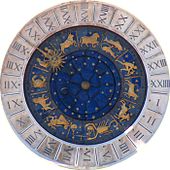| Astrology |
|---|
 |
| Background |
| Traditions |
| Branches |
| Astrological signs |
| Symbols |
The planetary hours are an ancient system in which one of the seven classical planets is given rulership over each day and various parts of the day. Developed in Hellenistic astrology, it has possible roots in older Babylonian astrology, and it is the origin of the names of the days of the week as used in English and numerous other languages.
The classical planets are Saturn, Jupiter, Mars, the Sun, Venus, Mercury and the Moon, and they take rulership over the hours in this sequence.
The sequence is from slowest- to fastest-moving as the planets appear in the night sky, and so is from furthest to nearest in the planetary spheres model. This order has come to be known as the "Chaldean order".[1]

As each day is divided into 24 hours, the first hour of a day is ruled by the planet three places down in the Chaldean order from the planet ruling the first hour of the preceding day;[2] i.e. a day with its first hour ruled by the Sun ("Sunday") is followed by a day with its first hour ruled by the Moon ("Monday"), followed by Mars ("Tuesday"), Mercury ("Wednesday"), Jupiter ("Thursday"), Venus ("Friday") and Saturn ("Saturday"), again followed by Sunday,[3] yielding the familiar naming of the days of the week.
- ^ The term "Chaldean order" is modern, used e.g. in Popular Science, January 1895, p. 335, but there is no evidence this order is actually taken from Babylonian astrology; rather, it seems to be a Hellenistic innovation of the 2nd century BC; see Eviatar Zerubavel, The Seven Day Circle: The History and Meaning of the Week, University of Chicago Press, 1989 [1985], p. 14.
- ^ The complete cycle of seven planets occurs three times in the day, occupying 7x3=21 hours. The day’s remaining three hours take the first three planets of the next cycle.
- ^ The day is divided into two parts; the day (time between sunrise and sunset) and the night (time between sunset and tomorrow's sunrise). Each part of the day is then divided into 12 equal parts, for a total of 24 (unequal) hours. The further the location is from the equator; and the closer the date is to the solstices (as opposed to the equinoxes); the greater the difference in length between the length of the planetary hours and the clock hours. Barrett, Francis (1989) [First printed in 1801]. "Book II. Part IV. The Magic and Philosophy of Trithemius of Spanheim". The Magus (First Carol Publishing Group ed.). New York: Carol Publishing Group. pp. 139–140. ISBN 0-8065-0462-5.